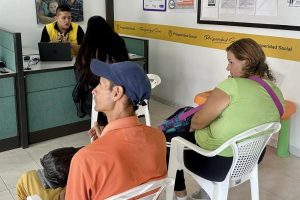The death of Ratzinger, pope emeritus, brings to the agenda the situation of the Catholic Church. Beyond the division between ultra-conservatives and more open sectors, the great metamorphosis that the institution is experiencing has to do with geography. While the bulk of the clergy is in the North, it is in the Global South that the adherents are increasing.
The Vaticanists do not seem to agree on what the future – or providence – holds for the Roman Church after the death of Benedict XVI, in whom Francis had a shield against his critics. For more years than his pontificate lasted, in his writings and confidences, the German pope, the first in 482 years, denied the versions that claimed he was forced to resign. “Nobody tried to blackmail me. I would not have allowed it,” he told his biographer Peter Seewald.
From his cloistered life in the Mater Ecclesiae monastery, the emeritus pope showed impeccable discretion and sensus Ecclesiae. On February 28, 2013, when he addressed the college of cardinals in Latin to announce his resignation, the first by a bishop of Rome since 1415, he told his members that among them was his successor, to whom he promised his “unquestioning reverence and obedience.” ”.
When the ex-archbishop of Buenos Aires called him at Castel Gandolfo on the afternoon of the day the conclave handed over the keys to San Pedro, Ratzinger repeated those same words to him. But the cohabitation of the two popes was not always easy.
In 2016, Archbishop Georg Gänswein, his personal secretary, suggested that two popes represented a kind of “expanded magisterium,” with one member “active and one contemplative.” In Nient’altro che la verità (2023) stresses the disappointment caused to Benedict by the decision of his “active” successor to discourage the mass of the Tridentine rite.
swords held high
In The Crux, John Allen writes that traditionalists have criticized the coldness of the theologian pope’s obsequies, contrasting them with Ratzinger’s emotional panegyric at John Paul II’s funeral. And he assures that they have already begun to move their bishops to ensure that it is their electors, and not the holy spirit, who choose the successor to the Argentine pope, the first non-European since the eighth century.
One of the favorites, according to Allen, is Guinean Cardinal Robert Sarah, a former prefect of a curia congregation that tried to involve the emeritus pope in an essay critical of Francis. If elected, he would be the first African pope and the second non-European after Bergoglio. From an animist family, Sarah converted to Catholicism as a teenager.
“John Allen (…) assures that the traditionalists have already begun to move their bishops to ensure that their voters are the ones who choose the successor to the Argentine pope”
Among the champions of the ultra-conservative camp is the former nuncio in Washington, Carlo Maria Viganò, who accuses Francis of being on the side of “the enemy” and Cardinal Raymond Burke, who accused him of “heresy” for speaking of “Mother Earth”, a pantheistic concept alien to the Catholic tradition, according to him.
The United States Conference of Bishops is the stronghold and epicenter of opposition to Bergoglio. In November, its bishops chose Archbishop Timothy Broglio, a former military chaplain for the armed forces, to succeed José Gómez, Archbishop of Los Angeles. Francisco did not grant Gómez the cardinal’s hat, ignoring an unwritten ecclesial norm. In his place he appointed a suffragan, San Diego Bishop Robert McElroy, an openly progressive. The conservatives, in retaliation, did not choose any of the cardinals created by Francis to serve in the Conference.
schism risks
Speaking to reporters, Francis said in 2019 that he “prayed” that there would not be a schism, but that he was not afraid of a new one or his eventual antipopes. In the middle are Italy, Spain and France, with churches more or less equidistant between that of Germany, which has been challenging the Holy See for years, and that of Poland, the other pole of the European Catholic spectrum.
The problem with ultra-conservatives is that they swim against the current. Churches in the Global South, the only region in the world where Catholicism continues to gain adherents, have eclipsed those in the Global North.
In the church burns (2021) Andrea Riccardi, founder of the community of Sant’Egidio, warns that secularization is bringing Catholicism to a “terminal phase” in France, the “firstborn daughter of the Church”. If the trend continues, he points out, the last Catholic wedding could be celebrated in 2031 and the last baptism in 2044. In 2018, two thirds of the French dioceses did not have seminarians and only 114 were ordained, 20% of fundamentalist orders.
The French case is extreme, but not very different from that of other European countries. In Spain, in 2021 only one in 10 weddings were religious, compared to 76% two decades ago. Since 2010, when clergy pedophilia scandals began to come to light, more than 2.5 million German Catholics have apostatized, asking to have their names removed from parish registers. Only last year 400,000 unsubscribed, twice as many pilgrims who traveled to Rome for the Bavarian Pope’s funeral.
The end of the Constantine era
In Benedict up close (2017), Paul Badde writes that with Ratzinger the “era of Constantine, the European era of the Church” ended. Maybe he’s not wrong. In 1900, there were 267 million Catholics in the world. Today there are 1,360 million. In the 20th century, Catholicism expanded more than in any other. But that growth occurred mostly in Africa and Asia.
«In the 20th century, Catholicism expanded more than in any other. But that growth occurred mainly in Africa and Asia »
Today, two thirds of Catholics live in the Global South and it will be three quarters by mid-century. In 1910, Europe was home to two-thirds of the Catholics. Today European Catholics only represent 11%. In 1910, 44% of Europeans were Catholic. In 2010, 35%. In the same period, African Catholics went from 1% to 21% of the total and those from Asia-Pacific from 1% to 3%.
According to him Statistical Yearbook of the Church 2022, in 2020 17.7% of the world population was Catholic. 48% were in the Americas and 28% in South America. Europeans, who were one in four Catholics in 2004, will be one in six in 2050. Italy and Poland will have 5.3 million fewer each.
And it’s just the beginning. Between 2004 and 2050, the Catholic population will increase by 146% in Africa, 63% in Asia, 42% in Latin America and the Caribbean, and 38% in North America. That of Europe, on the other hand, will fall by 6%. In 2050, Brazil and Mexico will continue to be the countries with the largest Catholic population, followed by the Philippines, which will displace the US. Democratic Republic of the Congo will triple its Catholic population, which will occupy fifth place on the list, compared to the current 11th. European countries will only have five representatives in the top 25. Among the first 10 will be in addition to DRC, Nigeria, Uganda, Colombia, Argentina and Angola.
The vine and the branches
Latin America, where the religious is intermingled with the political, is increasingly similar to Western Europe in matters of secularization. In 1985, 80% of Latin Americans called themselves Catholic. Today only 56% (with a strong growth of Protestants, Agnostics and non-religious). 20% of Venezuelans, Guatemalans, Hondurans and Salvadorans are Protestants. In Brazil they are 30%.
And they’re not that conservative either. More Latin American Catholics support same-sex marriage than in Italy or Poland, for example. The future of Catholicism lies elsewhere. Between 2010 and 2020, it grew fastest in Asia (+1.8%) and Africa (+2.1%).
“The problem is that more than 50% of active clergy live in the Global North, where only 30% of their faithful live”
The problem is that more than 50% of the active clergy live in the Global North, where only 30% of their faithful live. Some 236 million Africans are Catholic. The US and Canada together are home to 84 million, but have almost the same number of priests as all of Africa, which only has 12.3%. In Europe, the average is one priest for every 1,746 faithful; in the Americas one for every 2,086 and in Africa one for every 5,089. Allen believes that if all the foreign priests – Mexican, Vietnamese, Korean, Filipino, Congolese… – returned to their countries, parishes in the US would have to hang a sign on their doors: “Going out of business”.
the harvest is ripe
Of the almost 500 million new faithful that the Church will add between now and the middle of the century, the vast majority will come from countries like Nigeria or the DRC. In 1900 African Catholics were 1.9 million (1% of the total). Today there are 236 million (20%). Between 1950 and 2000, the African population grew by 313%. Catholics, 708%.
The Near East and North Africa, the cradle of Christianity, is home to less than 1% of Catholics, the same proportion as in 1900.
Bergoglio is aware of what those figures mean. In the next conclave, many cardinals from the “global peripheries” that he has created will participate: 121 cardinals from 66 countries. East Timor, Mongolia, Paraguay and Singapore had never had one. In 2013, Europeans made up 52% of the College of Cardinals. Today there are 53 (40%). The Italians have 20 voters (17%); but there were 28 (24%) in 2013.
The Global South now has 45%, up from 35% in 2013. Africans have gone from 9% to 14%, Asians from 9% to 12.5%, and Latin Americans and Caribbeans from 16% to 19%. The US only has nine (7%). In two successive consistories in August 2022, Francis created 20 new cardinals, 16 of them electors, bringing the total to 229. Only 132 are electors, that is, under 80 years of age, 83 created by Francis, 11 by John Paul II, and 38 by Benedict XVI.
One of the new cardinals is Giorgio Marengo, an Italian missionary and apostolic prefect of Ulaanbaatar, whose diocese is home to only six parishes with a thousand faithful. Mauro Gambetti, custodian of the convent of the Basilica of San Francisco in Assisi, is not even a bishop. Others are Wilton Gregory, archbishop of Washington and the first African-American cardinal, and Italian Oscar Cantoni, bishop of Como. As in the case of Gómez, Mario Delpini, archbishop of Milan, was left without the hat. Given that 63% of the new “princes of the church” were anointed by Francis, his successor will not need the votes of those who created his two predecessors.













